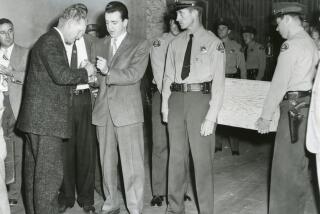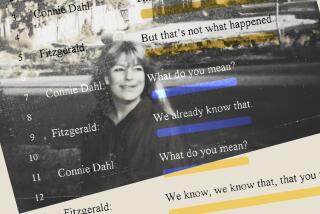Girl’s Grisly Killing Had City Residents Up in Arms
- Share via
It is every parent’s most horrific nightmare: a child’s violent death at the hands of a predator.
Nearly five years before the internationally reviled kidnapping of aviator Charles Lindbergh’s 20-month-old son in New Jersey in 1932, Angelenos reacted with that same horror and fear at the abduction and murder of a local girl, 12-year-old Marion Parker.
The grisly crime that left the child lifeless, dismembered and discarded along the streets of Los Angeles triggered one of the biggest manhunts in the West, and the first insanity plea under a new state law. National press coverage turned the 1927 tragedy into what many then considered the “crime of the century.”
Because the child and her parents, Geraldine and Perry Parker, were not global celebrities, the grim deeds are now mostly forgotten, eclipsed by more recent outrages. But few have been more revolting.
A former Kansas City high school scholastic star turned petty thief, 19-year-old William Edward Hickman began his life of crime pilfering candy at age 11. Shortly after meeting 16-year-old Welby Hunt, he graduated to forgery, armed robbery and murder.
In 1926, the teenagers put Kansas City behind them and headed to Los Angeles, where they lived with Hunt’s grandparents in Alhambra. (Hunt would later testify that Hickman once confided that “ . . . it was his wish to get someone and chop them up in little pieces and throw them along the highway.”)
On Christmas Eve 1926, the pair were holding up a Los Angeles drugstore when they were caught in a shootout that left one police officer shot in the abdomen and druggist Clarence Ivy Thoms mortally wounded.
After lying low for a time, the two resorted to jobs as messengers at a downtown bank. There they met Perry Parker, the bank’s chief clerk and the father of a son and twin girls.
The work at the bank had evidently not stopped the teenagers’ crime spree. On May 24, 1927, the morning after Hunt’s grandfather withdrew a large sum from his bank, his body was found beneath Pasadena’s Colorado Street bridge. The money was gone, but five suicide notes were left behind--written in two hands.
Hickman, in the meantime, had forged $400 worth of checks at the bank. He was fired and prosecuted. Out of work, he pulled off several penny-ante holdups. But by December, Hickman figured he had a sure-fire way to make money.
Ten days before Christmas, he walked confidently into Mount Vernon Junior High School and told a secretary that his employer, Perry Parker, had been hurt in an auto accident and wanted his “younger” daughter by his bedside. The secretary summoned Marion--not her older twin Marjorie--and she left with Hickman. It was the last time anyone saw her alive.
Within hours, a bizarre telegram arrived at the Parker house, followed by a letter demanding $1,500. “Get this straight,” it said. “Your daughter’s life hangs by a thread and I have a Gillette [a razor brand] ready and able to handle the situation.” It was signed “FOX-FATE.”
*
When Parker went the next night to drop off the ransom at 10th Street and Gramercy Place, Hickman was spooked when he saw police and, with the child still in the front seat of his coupe, drove back to his apartment.
A second exchange was arranged, but Hickman never intended to return the child alive. As she sat bound to a kitchen chair, he strangled her with a dish towel. (He would later testify that as he put her body in the bathtub, she “kind of came to, started to get up,” but he pushed her back down and stabbed and mutilated her.
The next night, Hickman drove to the designated drop-off point at Manhattan Place and 5th Street. Marion’s bundled-up figure sat next to him. He stopped the car when he saw Parker, leveled a shotgun out the window and demanded the money. Parker saw his daughter’s face in the darkened car and turned over the satchel.
Hickman accelerated, then screeched to a brief halt about 200 feet away and shoved out the bundle. It was Marion’s limbless torso. Her eyes had been sewn open to make it appear that she was alive. Her legs and arms would be found later, washed and neatly wrapped in newspaper and thrown throughout Elysian Park. Then Hickman vanished.
Fearful residents retreated to their homes. School attendance fell. Mexico’s governor closed the border to prevent the “Fox” from escaping into Mexico. Radio stations and newspapers appealed for information, and rewards for the killer’s arrest totaled $60,000.
After an autopsy found a blood-stained towel marked “Bellevue Arms Apartments” stuffed into Marion’s torso, police closed in. Detectives talked with Hickman, who was registered under an alias. But he slipped away under cover of night.
Pandemonium reigned for days. One man who resembled Hickman was arrested seven times within eight hours. He finally asked to stay in jail. Another look-alike was severely beaten by a mob. For safekeeping, police took him to jail, where he hanged himself.
Seven days after Marion’s abduction, Hickman was captured in Oregon after a frenetic car chase. With his hands up, he asked detectives if they thought he would be as famous as Nathan Leopold and Richard Loeb, the Chicago teenage “thrill killers” who in 1924 had murdered a 14-year-old boy to commit “the perfect crime.”
*
Hickman pleaded not guilty by reason of insanity. On Jan. 25, 1928, the first day of his trial, the crowd outside the Hall of Justice was in a lynch-mob mood. They gawked at Hollywood figures arriving to attend the trial. Already, newspaper headlines shrieked “Hickman Must Hang.”
Up on the eighth floor, hundreds waiting to get into the trial almost rioted when Superior Court Judge Carlos Hardy began issuing reserved seats to his political cronies and his wife’s guests.
At the end of the weeks-long trial, jurors deliberated for 43 minutes. The 2,000 people gathered around the Hall of Justice for the verdict greeted it with cheers: Hickman was sane, and would hang. The murder had taken place three months after California narrowed the standards for insanity.
(Days later, in a separate trial, Hickman and Hunt were found guilty of murdering the druggist, and both sentenced to prison--moot, in Hickman’s case.)
During eight months of appeals, Hickman, on San Quentin’s death row, embraced Catholicism and wrote apologetic letters to his victims’ families. On a damp, foggy day in October, radio broadcasters stood outside the prison gates to report Hickman’s death on the gallows.
Inside, scores of reporters and guests pushed and shoved to get the best seats. They watched as guards brought in Hickman, his arms strapped to his sides. He mounted the 13 steps to the gallows. A priest followed, praying aloud: “Lord, have mercy on us.” Hickman responded: “Christ have mercy on us.”
After the black hood went over his head, the trap doors fell away. Death wasn’t instantaneous. Hickman struck his head on the side of the gallows as he fell and hung there, violently twitching and jerking.
After a few moments, a prison doctor climbed a stepladder beneath the gallows, ripped open Hickman’s shirt and put a stethoscope to his chest. As the body swung back and forth, the doctor moved with it before finally shouting “Deceased!”
An autopsy report would later state that his neck did not break. Hickman, who had at first tried to strangle his young victim, had been strangled himself.
More to Read
Sign up for Essential California
The most important California stories and recommendations in your inbox every morning.
You may occasionally receive promotional content from the Los Angeles Times.










